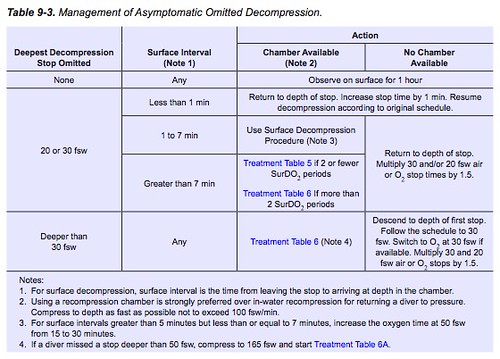Bubbletrubble
Contributor
I would leave the "ratio deco" method to the courageous souls who don't mind being guinea pigs.what is the approach? what is the approach? I really want to know. I will look up ratio deco just to understand it in case if I need it. I don't plan to do deco dive. In fact, recreation dive (<=100ft)with GUE min gas requirement and EAN32, one would never go into deco with a single tank setup.
But I still want to know what is the approach for "accidently deco".
A straightforward approach for a recreational diver who finds himself in an unintentional deco situation without a functioning computer to help direct his stop schedule prior to surfacing is to conduct an extended stop at depth of 15 fsw for 15-20 minutes or until tank pressure falls to 300 psi or until the diver becomes unable to remain in the water (too cold?). This assumes that the diver is aware of the deco situation prior to surfacing and that he didn't incur a ridiculous amount of deco. Obviously, if the diver's computer is still functioning and giving reasonable deco instructions, those instructions should be followed. If the diver's computer isn't working, then his buddy's computer should be consulted. Arguably, the most conservative method would be to simply do the best you can with the gas supply remaining, i.e., extend the shallow stop until gas supply dwindles to approx. 300 psi. I'm sure that others will share their own rules of thumb.
If you're curious, a nice read is the US Navy recommended course of action for "omitted decompression."
In the 2008 USN Dive Manual, it's illustrated in Table 9-3. Here's a download link to the entire 2008 US Navy Dive Manual (size ~20MB).

I think we can all agree that the best course of action for a diver not trained in deco procedures is to avoid crossing the line into deco in the first place.
For what it's worth, I've had a number of discussions with divers trained to conduct deco dives and actively doing them who have a...let's just say...rather simplistic understanding of deco theory. Perhaps I was just unlucky enough to encounter folks who were rusty on their "book knowledge" or received their training prior to the advent of current "best practice" procedures.

But then again, I'm just a dumb recreational diver, so what do I know?
P.S. It's certainly possible to adhere to Rock Bottom, stay shallower than 100 fsw, breathe a 32% nitrox mix, and have enough of a gas supply to exceed NDLs.
Check my math...
Given: Dive to 90 fsw with a SAC/RMV of 0.5 cuft/min breathing 32% mix with no prior dives
90 fsw = 3.73 ata
3.73 * 0.5 cuft/min = 1.87 cuft/min (gas consumption rate at 90 fsw)
Equivalent air depth of breathing 32% nitrox at 90 fsw = about 73 fsw
Consulting the PADI air dive tables, at 80 fsw, NDLs = 30 min.
1.87 cuft/min * 30 min = 56 cuft.
Rock Bottom for 90 fsw = about 31 cuft.
With a HP100, a diver would have enough gas to go into deco at 90 fsw without violating Rock Bottom reserve.
My typical SAC/RMV is around 0.4 cuft/min, so theoretically on 32% nitrox I could exceed NDLs with an AL80 while still adhering to Rock Bottom reserve.
3.73 * 0.4 cuft/min = 1.49 cuft/min (gas consumption rate at 90 fsw)
1.49 cuft/min * 30 min = 45 cuft.
Rock Bottom for 90 fsw = about 31 cuft.
FWIW, my typical tank is a HP100.
Last edited:




